Personal and Professional Development: Skills, Plans, and Evaluation
VerifiedAdded on 2020/06/04
|11
|4593
|468
Report
AI Summary
This report delves into the realm of personal and professional development, exploring various facets of self-managed learning and its benefits for both individuals and organizations. It examines approaches to self-learning, including seminars, the internet, and social media, and highlights methods to encourage lifelong learning, such as creativity, cooperation, and positive attitudes. The report then assesses current skills and competencies against professional standards, specifically focusing on the skills required for an HR role at Apple, such as recruitment knowledge, communication skills, and problem-solving abilities. Furthermore, it addresses personal and professional development areas like time management and effective communication, and outlines development opportunities to meet current and future needs. The report also presents a personal and professional development plan, including the processes and activities necessary for implementation, documentation, and critical reflection on learning outcomes, incorporating feedback for continuous improvement. Finally, it explores work-based problems and solutions, evaluates communication styles, and examines effective time management strategies within an organizational context.
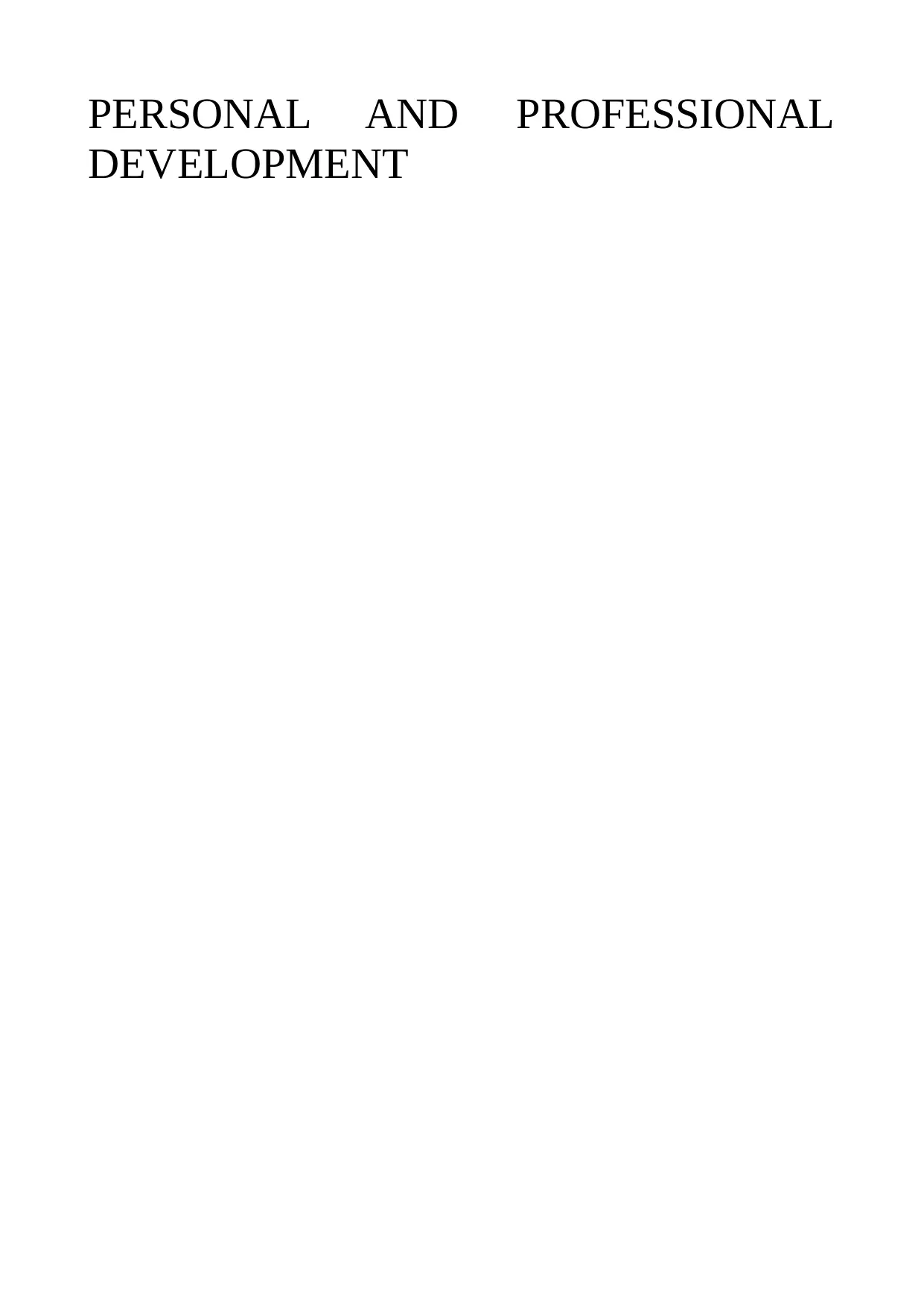
PERSONAL AND PROFESSIONAL
DEVELOPMENT
DEVELOPMENT
Paraphrase This Document
Need a fresh take? Get an instant paraphrase of this document with our AI Paraphraser
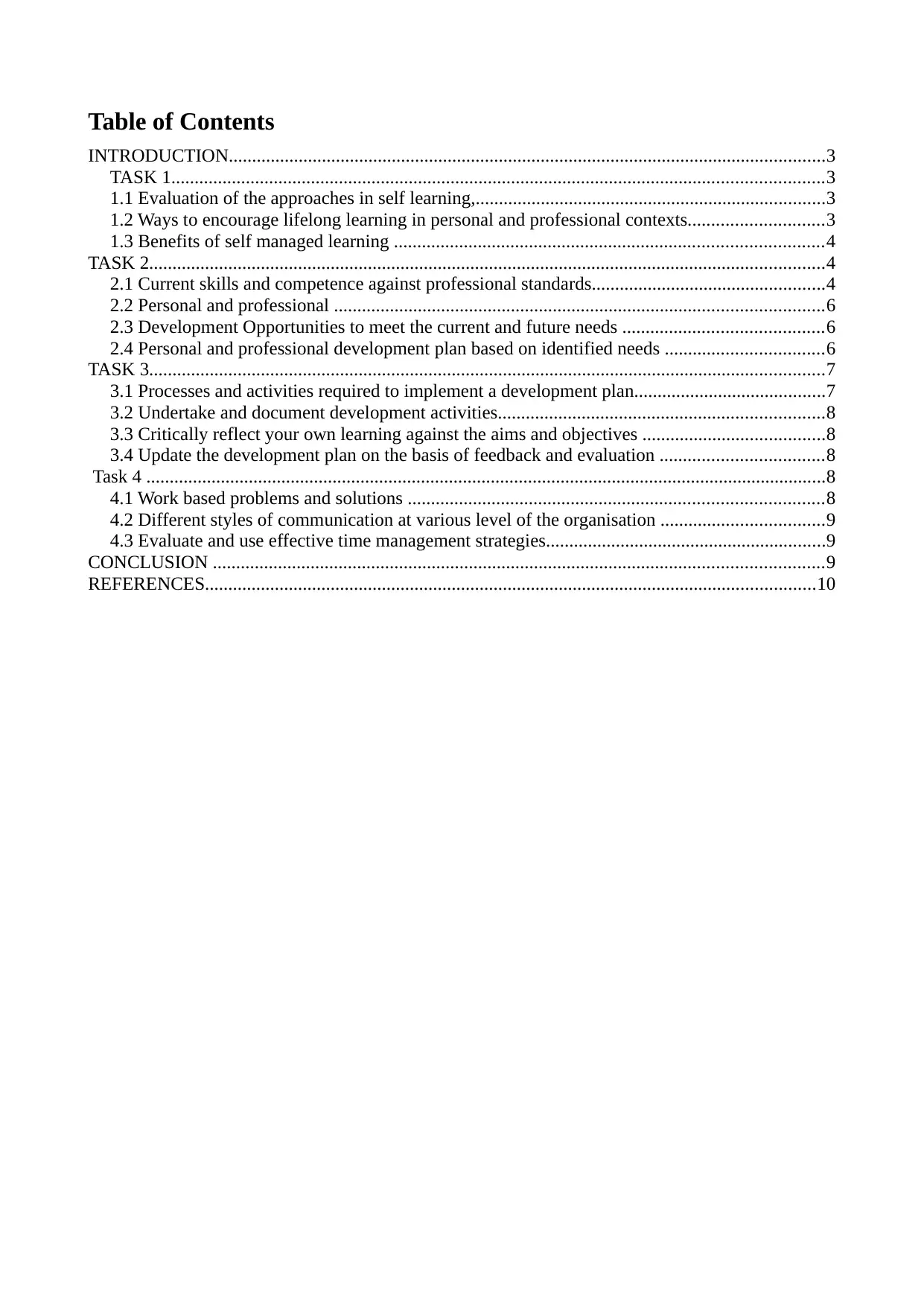
Table of Contents
INTRODUCTION................................................................................................................................3
TASK 1............................................................................................................................................3
1.1 Evaluation of the approaches in self learning,...........................................................................3
1.2 Ways to encourage lifelong learning in personal and professional contexts.............................3
1.3 Benefits of self managed learning ............................................................................................4
TASK 2.................................................................................................................................................4
2.1 Current skills and competence against professional standards..................................................4
2.2 Personal and professional .........................................................................................................6
2.3 Development Opportunities to meet the current and future needs ...........................................6
2.4 Personal and professional development plan based on identified needs ..................................6
TASK 3.................................................................................................................................................7
3.1 Processes and activities required to implement a development plan.........................................7
3.2 Undertake and document development activities......................................................................8
3.3 Critically reflect your own learning against the aims and objectives .......................................8
3.4 Update the development plan on the basis of feedback and evaluation ...................................8
Task 4 ..................................................................................................................................................8
4.1 Work based problems and solutions .........................................................................................8
4.2 Different styles of communication at various level of the organisation ...................................9
4.3 Evaluate and use effective time management strategies............................................................9
CONCLUSION ...................................................................................................................................9
REFERENCES...................................................................................................................................10
INTRODUCTION................................................................................................................................3
TASK 1............................................................................................................................................3
1.1 Evaluation of the approaches in self learning,...........................................................................3
1.2 Ways to encourage lifelong learning in personal and professional contexts.............................3
1.3 Benefits of self managed learning ............................................................................................4
TASK 2.................................................................................................................................................4
2.1 Current skills and competence against professional standards..................................................4
2.2 Personal and professional .........................................................................................................6
2.3 Development Opportunities to meet the current and future needs ...........................................6
2.4 Personal and professional development plan based on identified needs ..................................6
TASK 3.................................................................................................................................................7
3.1 Processes and activities required to implement a development plan.........................................7
3.2 Undertake and document development activities......................................................................8
3.3 Critically reflect your own learning against the aims and objectives .......................................8
3.4 Update the development plan on the basis of feedback and evaluation ...................................8
Task 4 ..................................................................................................................................................8
4.1 Work based problems and solutions .........................................................................................8
4.2 Different styles of communication at various level of the organisation ...................................9
4.3 Evaluate and use effective time management strategies............................................................9
CONCLUSION ...................................................................................................................................9
REFERENCES...................................................................................................................................10
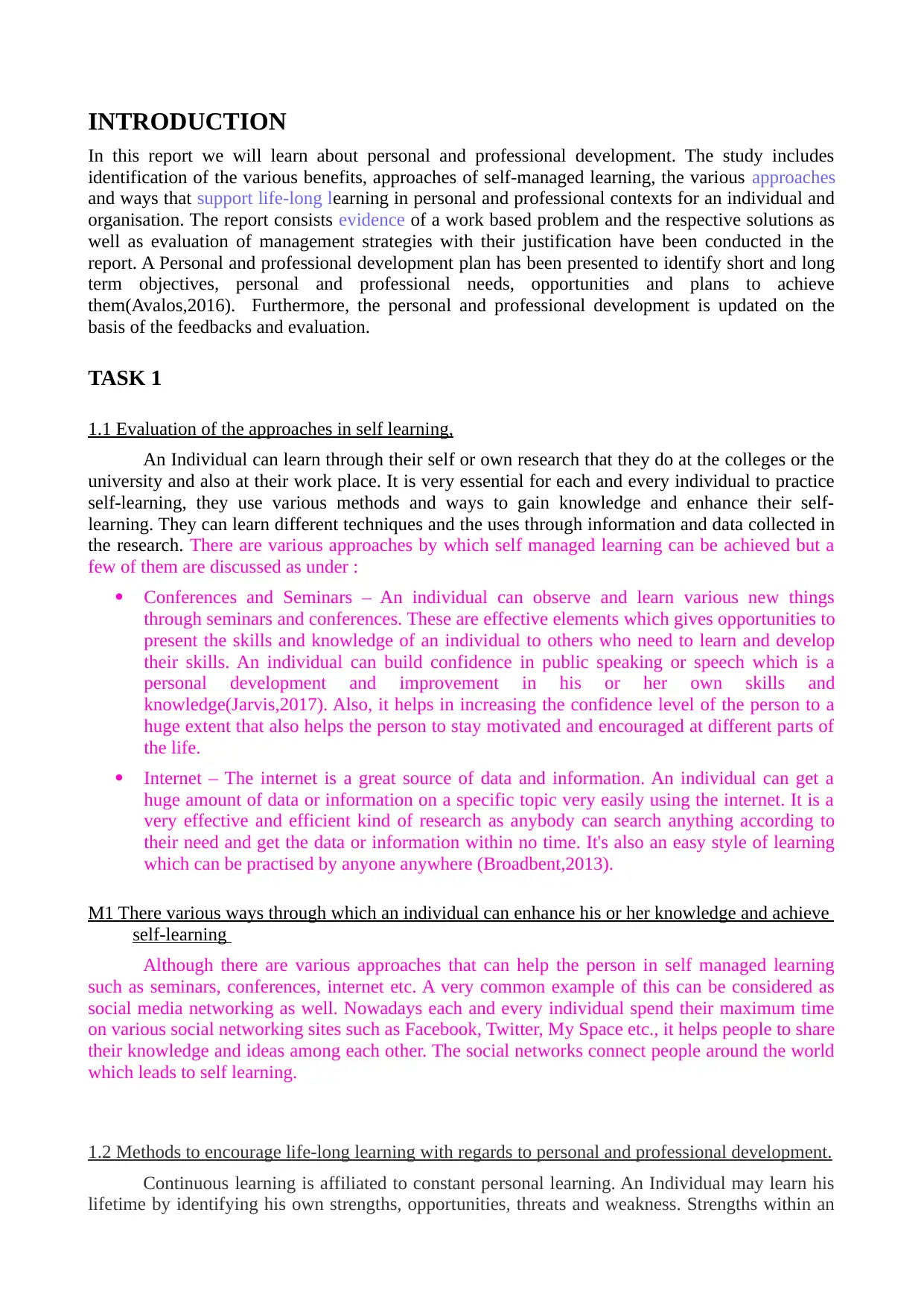
INTRODUCTION
In this report we will learn about personal and professional development. The study includes
identification of the various benefits, approaches of self-managed learning, the various approaches
and ways that support life-long learning in personal and professional contexts for an individual and
organisation. The report consists evidence of a work based problem and the respective solutions as
well as evaluation of management strategies with their justification have been conducted in the
report. A Personal and professional development plan has been presented to identify short and long
term objectives, personal and professional needs, opportunities and plans to achieve
them(Avalos,2016). Furthermore, the personal and professional development is updated on the
basis of the feedbacks and evaluation.
TASK 1
1.1 Evaluation of the approaches in self learning,
An Individual can learn through their self or own research that they do at the colleges or the
university and also at their work place. It is very essential for each and every individual to practice
self-learning, they use various methods and ways to gain knowledge and enhance their self-
learning. They can learn different techniques and the uses through information and data collected in
the research. There are various approaches by which self managed learning can be achieved but a
few of them are discussed as under :
Conferences and Seminars – An individual can observe and learn various new things
through seminars and conferences. These are effective elements which gives opportunities to
present the skills and knowledge of an individual to others who need to learn and develop
their skills. An individual can build confidence in public speaking or speech which is a
personal development and improvement in his or her own skills and
knowledge(Jarvis,2017). Also, it helps in increasing the confidence level of the person to a
huge extent that also helps the person to stay motivated and encouraged at different parts of
the life.
Internet – The internet is a great source of data and information. An individual can get a
huge amount of data or information on a specific topic very easily using the internet. It is a
very effective and efficient kind of research as anybody can search anything according to
their need and get the data or information within no time. It's also an easy style of learning
which can be practised by anyone anywhere (Broadbent,2013).
M1 There various ways through which an individual can enhance his or her knowledge and achieve
self-learning
Although there are various approaches that can help the person in self managed learning
such as seminars, conferences, internet etc. A very common example of this can be considered as
social media networking as well. Nowadays each and every individual spend their maximum time
on various social networking sites such as Facebook, Twitter, My Space etc., it helps people to share
their knowledge and ideas among each other. The social networks connect people around the world
which leads to self learning.
1.2 Methods to encourage life-long learning with regards to personal and professional development.
Continuous learning is affiliated to constant personal learning. An Individual may learn his
lifetime by identifying his own strengths, opportunities, threats and weakness. Strengths within an
In this report we will learn about personal and professional development. The study includes
identification of the various benefits, approaches of self-managed learning, the various approaches
and ways that support life-long learning in personal and professional contexts for an individual and
organisation. The report consists evidence of a work based problem and the respective solutions as
well as evaluation of management strategies with their justification have been conducted in the
report. A Personal and professional development plan has been presented to identify short and long
term objectives, personal and professional needs, opportunities and plans to achieve
them(Avalos,2016). Furthermore, the personal and professional development is updated on the
basis of the feedbacks and evaluation.
TASK 1
1.1 Evaluation of the approaches in self learning,
An Individual can learn through their self or own research that they do at the colleges or the
university and also at their work place. It is very essential for each and every individual to practice
self-learning, they use various methods and ways to gain knowledge and enhance their self-
learning. They can learn different techniques and the uses through information and data collected in
the research. There are various approaches by which self managed learning can be achieved but a
few of them are discussed as under :
Conferences and Seminars – An individual can observe and learn various new things
through seminars and conferences. These are effective elements which gives opportunities to
present the skills and knowledge of an individual to others who need to learn and develop
their skills. An individual can build confidence in public speaking or speech which is a
personal development and improvement in his or her own skills and
knowledge(Jarvis,2017). Also, it helps in increasing the confidence level of the person to a
huge extent that also helps the person to stay motivated and encouraged at different parts of
the life.
Internet – The internet is a great source of data and information. An individual can get a
huge amount of data or information on a specific topic very easily using the internet. It is a
very effective and efficient kind of research as anybody can search anything according to
their need and get the data or information within no time. It's also an easy style of learning
which can be practised by anyone anywhere (Broadbent,2013).
M1 There various ways through which an individual can enhance his or her knowledge and achieve
self-learning
Although there are various approaches that can help the person in self managed learning
such as seminars, conferences, internet etc. A very common example of this can be considered as
social media networking as well. Nowadays each and every individual spend their maximum time
on various social networking sites such as Facebook, Twitter, My Space etc., it helps people to share
their knowledge and ideas among each other. The social networks connect people around the world
which leads to self learning.
1.2 Methods to encourage life-long learning with regards to personal and professional development.
Continuous learning is affiliated to constant personal learning. An Individual may learn his
lifetime by identifying his own strengths, opportunities, threats and weakness. Strengths within an
⊘ This is a preview!⊘
Do you want full access?
Subscribe today to unlock all pages.

Trusted by 1+ million students worldwide
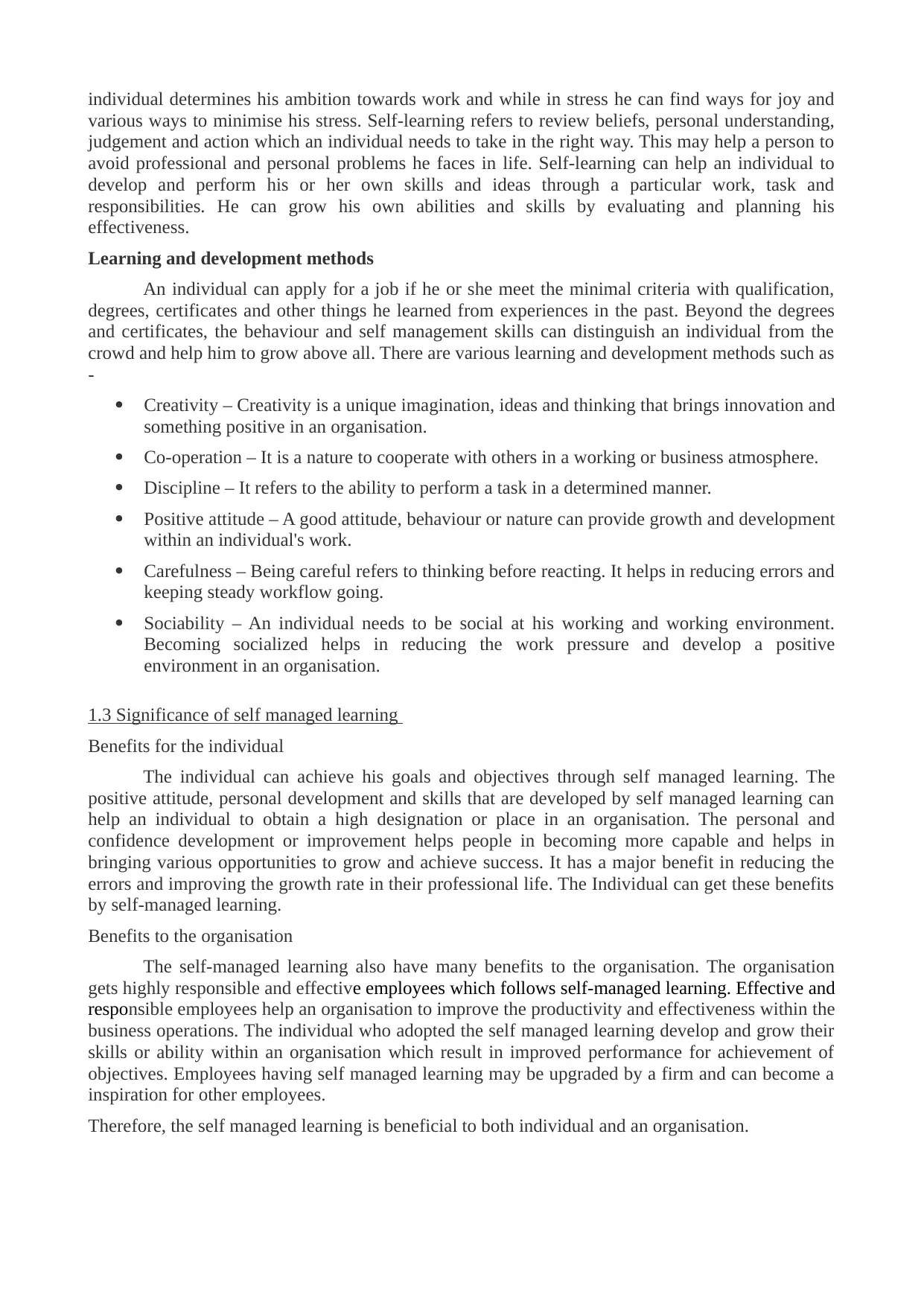
individual determines his ambition towards work and while in stress he can find ways for joy and
various ways to minimise his stress. Self-learning refers to review beliefs, personal understanding,
judgement and action which an individual needs to take in the right way. This may help a person to
avoid professional and personal problems he faces in life. Self-learning can help an individual to
develop and perform his or her own skills and ideas through a particular work, task and
responsibilities. He can grow his own abilities and skills by evaluating and planning his
effectiveness.
Learning and development methods
An individual can apply for a job if he or she meet the minimal criteria with qualification,
degrees, certificates and other things he learned from experiences in the past. Beyond the degrees
and certificates, the behaviour and self management skills can distinguish an individual from the
crowd and help him to grow above all. There are various learning and development methods such as
-
Creativity – Creativity is a unique imagination, ideas and thinking that brings innovation and
something positive in an organisation.
Co-operation – It is a nature to cooperate with others in a working or business atmosphere.
Discipline – It refers to the ability to perform a task in a determined manner.
Positive attitude – A good attitude, behaviour or nature can provide growth and development
within an individual's work.
Carefulness – Being careful refers to thinking before reacting. It helps in reducing errors and
keeping steady workflow going.
Sociability – An individual needs to be social at his working and working environment.
Becoming socialized helps in reducing the work pressure and develop a positive
environment in an organisation.
1.3 Significance of self managed learning
Benefits for the individual
The individual can achieve his goals and objectives through self managed learning. The
positive attitude, personal development and skills that are developed by self managed learning can
help an individual to obtain a high designation or place in an organisation. The personal and
confidence development or improvement helps people in becoming more capable and helps in
bringing various opportunities to grow and achieve success. It has a major benefit in reducing the
errors and improving the growth rate in their professional life. The Individual can get these benefits
by self-managed learning.
Benefits to the organisation
The self-managed learning also have many benefits to the organisation. The organisation
gets highly responsible and effective employees which follows self-managed learning. Effective and
responsible employees help an organisation to improve the productivity and effectiveness within the
business operations. The individual who adopted the self managed learning develop and grow their
skills or ability within an organisation which result in improved performance for achievement of
objectives. Employees having self managed learning may be upgraded by a firm and can become a
inspiration for other employees.
Therefore, the self managed learning is beneficial to both individual and an organisation.
various ways to minimise his stress. Self-learning refers to review beliefs, personal understanding,
judgement and action which an individual needs to take in the right way. This may help a person to
avoid professional and personal problems he faces in life. Self-learning can help an individual to
develop and perform his or her own skills and ideas through a particular work, task and
responsibilities. He can grow his own abilities and skills by evaluating and planning his
effectiveness.
Learning and development methods
An individual can apply for a job if he or she meet the minimal criteria with qualification,
degrees, certificates and other things he learned from experiences in the past. Beyond the degrees
and certificates, the behaviour and self management skills can distinguish an individual from the
crowd and help him to grow above all. There are various learning and development methods such as
-
Creativity – Creativity is a unique imagination, ideas and thinking that brings innovation and
something positive in an organisation.
Co-operation – It is a nature to cooperate with others in a working or business atmosphere.
Discipline – It refers to the ability to perform a task in a determined manner.
Positive attitude – A good attitude, behaviour or nature can provide growth and development
within an individual's work.
Carefulness – Being careful refers to thinking before reacting. It helps in reducing errors and
keeping steady workflow going.
Sociability – An individual needs to be social at his working and working environment.
Becoming socialized helps in reducing the work pressure and develop a positive
environment in an organisation.
1.3 Significance of self managed learning
Benefits for the individual
The individual can achieve his goals and objectives through self managed learning. The
positive attitude, personal development and skills that are developed by self managed learning can
help an individual to obtain a high designation or place in an organisation. The personal and
confidence development or improvement helps people in becoming more capable and helps in
bringing various opportunities to grow and achieve success. It has a major benefit in reducing the
errors and improving the growth rate in their professional life. The Individual can get these benefits
by self-managed learning.
Benefits to the organisation
The self-managed learning also have many benefits to the organisation. The organisation
gets highly responsible and effective employees which follows self-managed learning. Effective and
responsible employees help an organisation to improve the productivity and effectiveness within the
business operations. The individual who adopted the self managed learning develop and grow their
skills or ability within an organisation which result in improved performance for achievement of
objectives. Employees having self managed learning may be upgraded by a firm and can become a
inspiration for other employees.
Therefore, the self managed learning is beneficial to both individual and an organisation.
Paraphrase This Document
Need a fresh take? Get an instant paraphrase of this document with our AI Paraphraser
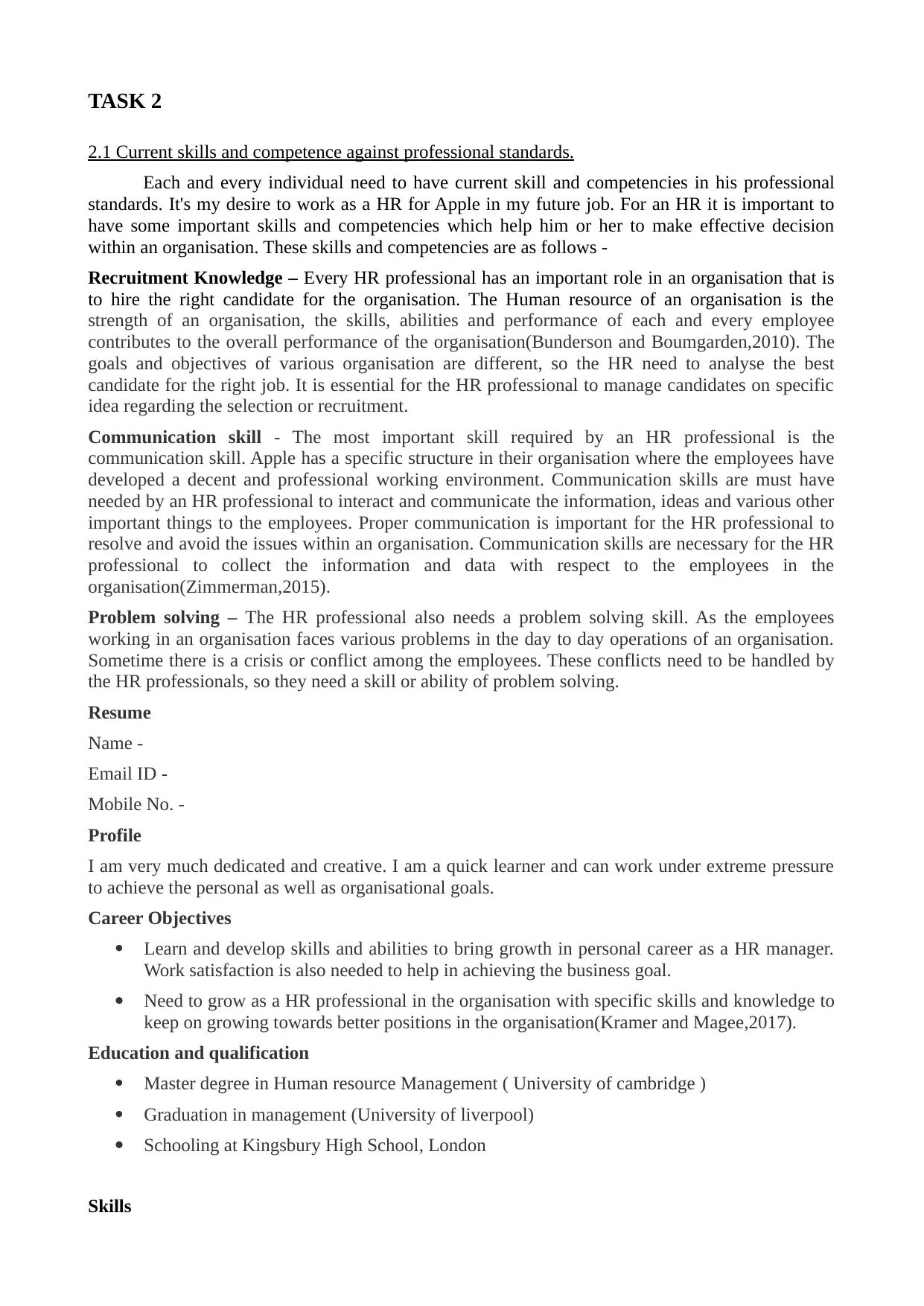
TASK 2
2.1 Current skills and competence against professional standards.
Each and every individual need to have current skill and competencies in his professional
standards. It's my desire to work as a HR for Apple in my future job. For an HR it is important to
have some important skills and competencies which help him or her to make effective decision
within an organisation. These skills and competencies are as follows -
Recruitment Knowledge – Every HR professional has an important role in an organisation that is
to hire the right candidate for the organisation. The Human resource of an organisation is the
strength of an organisation, the skills, abilities and performance of each and every employee
contributes to the overall performance of the organisation(Bunderson and Boumgarden,2010). The
goals and objectives of various organisation are different, so the HR need to analyse the best
candidate for the right job. It is essential for the HR professional to manage candidates on specific
idea regarding the selection or recruitment.
Communication skill - The most important skill required by an HR professional is the
communication skill. Apple has a specific structure in their organisation where the employees have
developed a decent and professional working environment. Communication skills are must have
needed by an HR professional to interact and communicate the information, ideas and various other
important things to the employees. Proper communication is important for the HR professional to
resolve and avoid the issues within an organisation. Communication skills are necessary for the HR
professional to collect the information and data with respect to the employees in the
organisation(Zimmerman,2015).
Problem solving – The HR professional also needs a problem solving skill. As the employees
working in an organisation faces various problems in the day to day operations of an organisation.
Sometime there is a crisis or conflict among the employees. These conflicts need to be handled by
the HR professionals, so they need a skill or ability of problem solving.
Resume
Name -
Email ID -
Mobile No. -
Profile
I am very much dedicated and creative. I am a quick learner and can work under extreme pressure
to achieve the personal as well as organisational goals.
Career Objectives
Learn and develop skills and abilities to bring growth in personal career as a HR manager.
Work satisfaction is also needed to help in achieving the business goal.
Need to grow as a HR professional in the organisation with specific skills and knowledge to
keep on growing towards better positions in the organisation(Kramer and Magee,2017).
Education and qualification
Master degree in Human resource Management ( University of cambridge )
Graduation in management (University of liverpool)
Schooling at Kingsbury High School, London
Skills
2.1 Current skills and competence against professional standards.
Each and every individual need to have current skill and competencies in his professional
standards. It's my desire to work as a HR for Apple in my future job. For an HR it is important to
have some important skills and competencies which help him or her to make effective decision
within an organisation. These skills and competencies are as follows -
Recruitment Knowledge – Every HR professional has an important role in an organisation that is
to hire the right candidate for the organisation. The Human resource of an organisation is the
strength of an organisation, the skills, abilities and performance of each and every employee
contributes to the overall performance of the organisation(Bunderson and Boumgarden,2010). The
goals and objectives of various organisation are different, so the HR need to analyse the best
candidate for the right job. It is essential for the HR professional to manage candidates on specific
idea regarding the selection or recruitment.
Communication skill - The most important skill required by an HR professional is the
communication skill. Apple has a specific structure in their organisation where the employees have
developed a decent and professional working environment. Communication skills are must have
needed by an HR professional to interact and communicate the information, ideas and various other
important things to the employees. Proper communication is important for the HR professional to
resolve and avoid the issues within an organisation. Communication skills are necessary for the HR
professional to collect the information and data with respect to the employees in the
organisation(Zimmerman,2015).
Problem solving – The HR professional also needs a problem solving skill. As the employees
working in an organisation faces various problems in the day to day operations of an organisation.
Sometime there is a crisis or conflict among the employees. These conflicts need to be handled by
the HR professionals, so they need a skill or ability of problem solving.
Resume
Name -
Email ID -
Mobile No. -
Profile
I am very much dedicated and creative. I am a quick learner and can work under extreme pressure
to achieve the personal as well as organisational goals.
Career Objectives
Learn and develop skills and abilities to bring growth in personal career as a HR manager.
Work satisfaction is also needed to help in achieving the business goal.
Need to grow as a HR professional in the organisation with specific skills and knowledge to
keep on growing towards better positions in the organisation(Kramer and Magee,2017).
Education and qualification
Master degree in Human resource Management ( University of cambridge )
Graduation in management (University of liverpool)
Schooling at Kingsbury High School, London
Skills
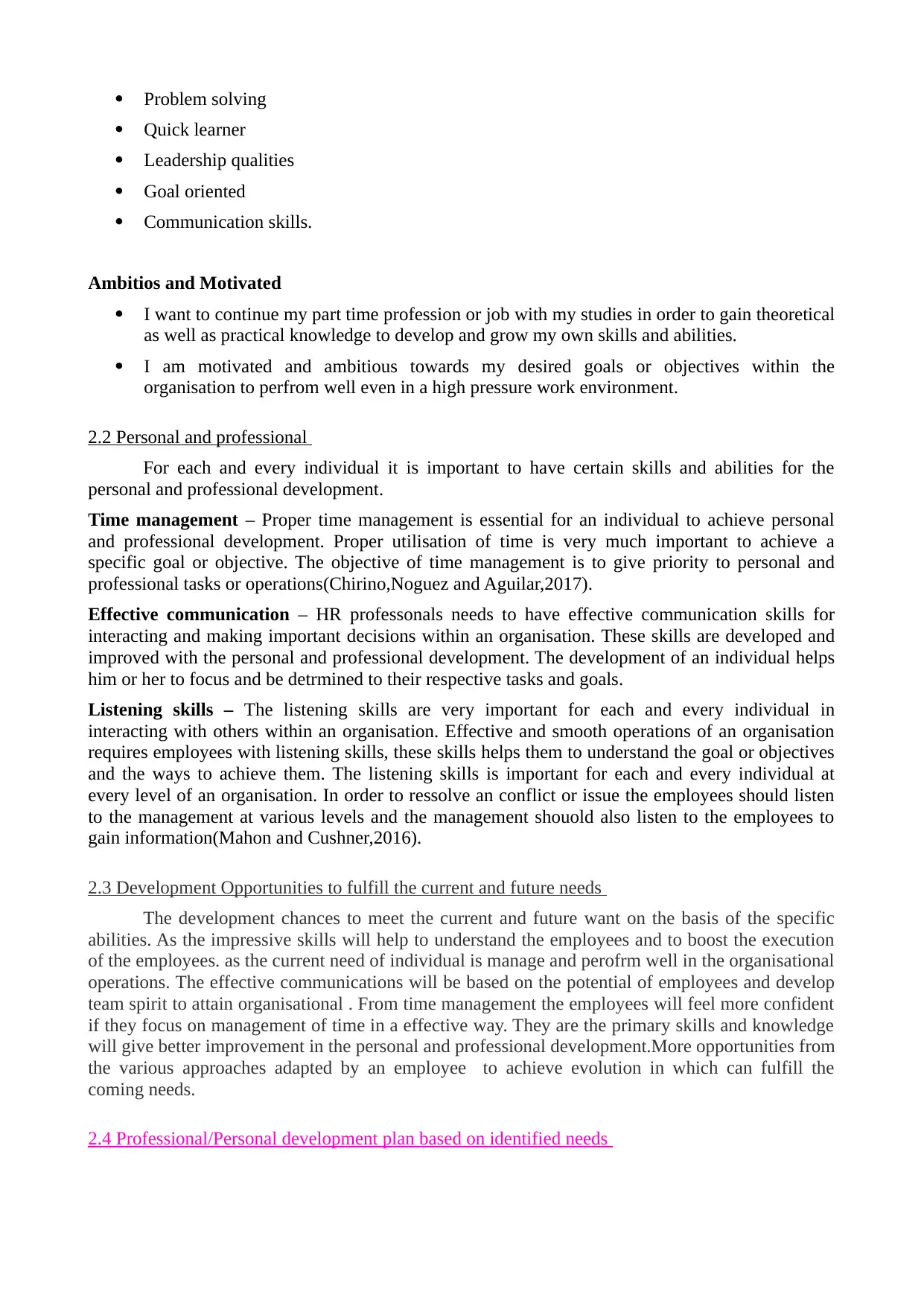
Problem solving
Quick learner
Leadership qualities
Goal oriented
Communication skills.
Ambitios and Motivated
I want to continue my part time profession or job with my studies in order to gain theoretical
as well as practical knowledge to develop and grow my own skills and abilities.
I am motivated and ambitious towards my desired goals or objectives within the
organisation to perfrom well even in a high pressure work environment.
2.2 Personal and professional
For each and every individual it is important to have certain skills and abilities for the
personal and professional development.
Time management – Proper time management is essential for an individual to achieve personal
and professional development. Proper utilisation of time is very much important to achieve a
specific goal or objective. The objective of time management is to give priority to personal and
professional tasks or operations(Chirino,Noguez and Aguilar,2017).
Effective communication – HR professonals needs to have effective communication skills for
interacting and making important decisions within an organisation. These skills are developed and
improved with the personal and professional development. The development of an individual helps
him or her to focus and be detrmined to their respective tasks and goals.
Listening skills – The listening skills are very important for each and every individual in
interacting with others within an organisation. Effective and smooth operations of an organisation
requires employees with listening skills, these skills helps them to understand the goal or objectives
and the ways to achieve them. The listening skills is important for each and every individual at
every level of an organisation. In order to ressolve an conflict or issue the employees should listen
to the management at various levels and the management shouold also listen to the employees to
gain information(Mahon and Cushner,2016).
2.3 Development Opportunities to fulfill the current and future needs
The development chances to meet the current and future want on the basis of the specific
abilities. As the impressive skills will help to understand the employees and to boost the execution
of the employees. as the current need of individual is manage and perofrm well in the organisational
operations. The effective communications will be based on the potential of employees and develop
team spirit to attain organisational . From time management the employees will feel more confident
if they focus on management of time in a effective way. They are the primary skills and knowledge
will give better improvement in the personal and professional development.More opportunities from
the various approaches adapted by an employee to achieve evolution in which can fulfill the
coming needs.
2.4 Professional/Personal development plan based on identified needs
Quick learner
Leadership qualities
Goal oriented
Communication skills.
Ambitios and Motivated
I want to continue my part time profession or job with my studies in order to gain theoretical
as well as practical knowledge to develop and grow my own skills and abilities.
I am motivated and ambitious towards my desired goals or objectives within the
organisation to perfrom well even in a high pressure work environment.
2.2 Personal and professional
For each and every individual it is important to have certain skills and abilities for the
personal and professional development.
Time management – Proper time management is essential for an individual to achieve personal
and professional development. Proper utilisation of time is very much important to achieve a
specific goal or objective. The objective of time management is to give priority to personal and
professional tasks or operations(Chirino,Noguez and Aguilar,2017).
Effective communication – HR professonals needs to have effective communication skills for
interacting and making important decisions within an organisation. These skills are developed and
improved with the personal and professional development. The development of an individual helps
him or her to focus and be detrmined to their respective tasks and goals.
Listening skills – The listening skills are very important for each and every individual in
interacting with others within an organisation. Effective and smooth operations of an organisation
requires employees with listening skills, these skills helps them to understand the goal or objectives
and the ways to achieve them. The listening skills is important for each and every individual at
every level of an organisation. In order to ressolve an conflict or issue the employees should listen
to the management at various levels and the management shouold also listen to the employees to
gain information(Mahon and Cushner,2016).
2.3 Development Opportunities to fulfill the current and future needs
The development chances to meet the current and future want on the basis of the specific
abilities. As the impressive skills will help to understand the employees and to boost the execution
of the employees. as the current need of individual is manage and perofrm well in the organisational
operations. The effective communications will be based on the potential of employees and develop
team spirit to attain organisational . From time management the employees will feel more confident
if they focus on management of time in a effective way. They are the primary skills and knowledge
will give better improvement in the personal and professional development.More opportunities from
the various approaches adapted by an employee to achieve evolution in which can fulfill the
coming needs.
2.4 Professional/Personal development plan based on identified needs
⊘ This is a preview!⊘
Do you want full access?
Subscribe today to unlock all pages.

Trusted by 1+ million students worldwide
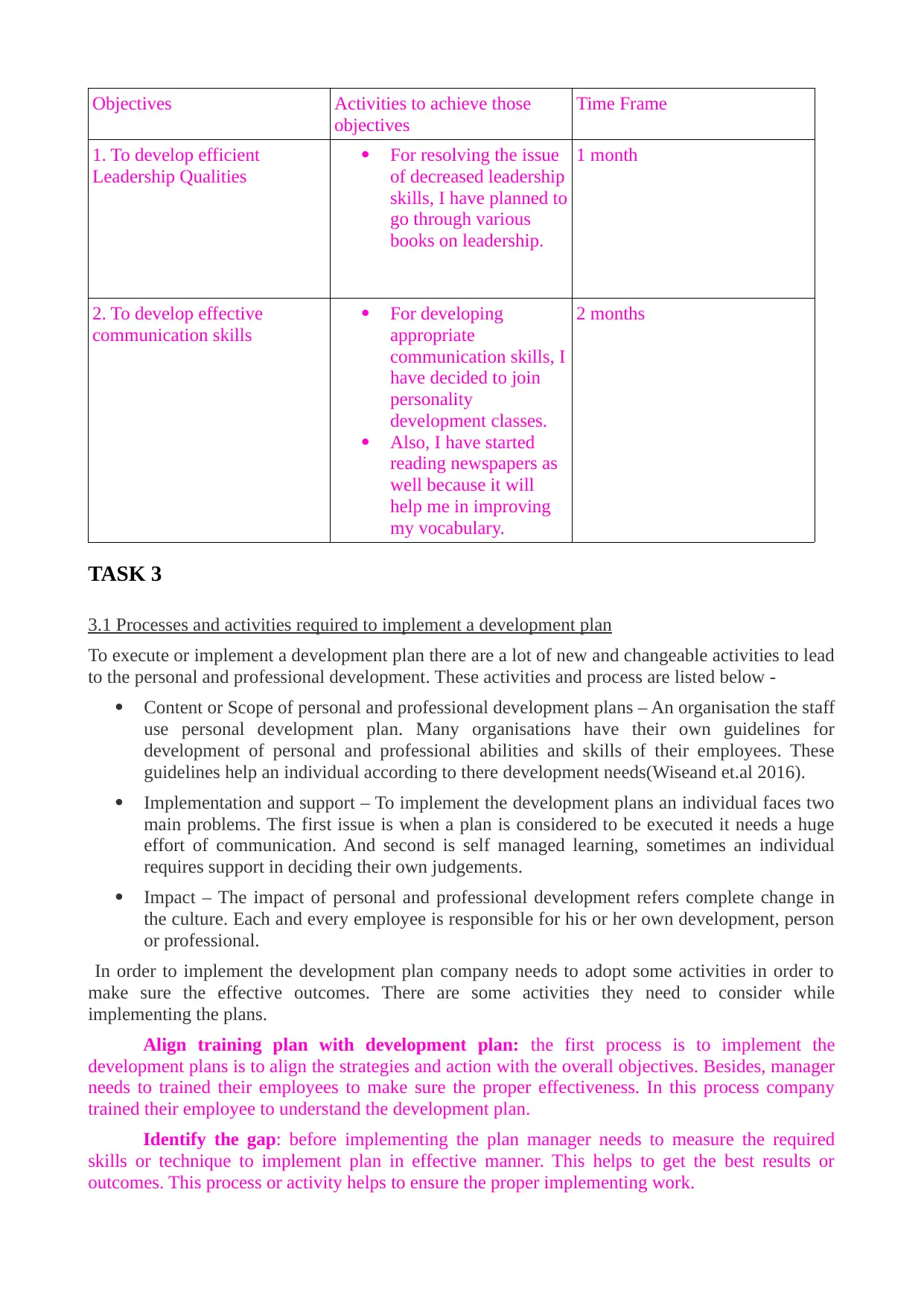
Objectives Activities to achieve those
objectives
Time Frame
1. To develop efficient
Leadership Qualities
For resolving the issue
of decreased leadership
skills, I have planned to
go through various
books on leadership.
1 month
2. To develop effective
communication skills
For developing
appropriate
communication skills, I
have decided to join
personality
development classes.
Also, I have started
reading newspapers as
well because it will
help me in improving
my vocabulary.
2 months
TASK 3
3.1 Processes and activities required to implement a development plan
To execute or implement a development plan there are a lot of new and changeable activities to lead
to the personal and professional development. These activities and process are listed below -
Content or Scope of personal and professional development plans – An organisation the staff
use personal development plan. Many organisations have their own guidelines for
development of personal and professional abilities and skills of their employees. These
guidelines help an individual according to there development needs(Wiseand et.al 2016).
Implementation and support – To implement the development plans an individual faces two
main problems. The first issue is when a plan is considered to be executed it needs a huge
effort of communication. And second is self managed learning, sometimes an individual
requires support in deciding their own judgements.
Impact – The impact of personal and professional development refers complete change in
the culture. Each and every employee is responsible for his or her own development, person
or professional.
In order to implement the development plan company needs to adopt some activities in order to
make sure the effective outcomes. There are some activities they need to consider while
implementing the plans.
Align training plan with development plan: the first process is to implement the
development plans is to align the strategies and action with the overall objectives. Besides, manager
needs to trained their employees to make sure the proper effectiveness. In this process company
trained their employee to understand the development plan.
Identify the gap: before implementing the plan manager needs to measure the required
skills or technique to implement plan in effective manner. This helps to get the best results or
outcomes. This process or activity helps to ensure the proper implementing work.
objectives
Time Frame
1. To develop efficient
Leadership Qualities
For resolving the issue
of decreased leadership
skills, I have planned to
go through various
books on leadership.
1 month
2. To develop effective
communication skills
For developing
appropriate
communication skills, I
have decided to join
personality
development classes.
Also, I have started
reading newspapers as
well because it will
help me in improving
my vocabulary.
2 months
TASK 3
3.1 Processes and activities required to implement a development plan
To execute or implement a development plan there are a lot of new and changeable activities to lead
to the personal and professional development. These activities and process are listed below -
Content or Scope of personal and professional development plans – An organisation the staff
use personal development plan. Many organisations have their own guidelines for
development of personal and professional abilities and skills of their employees. These
guidelines help an individual according to there development needs(Wiseand et.al 2016).
Implementation and support – To implement the development plans an individual faces two
main problems. The first issue is when a plan is considered to be executed it needs a huge
effort of communication. And second is self managed learning, sometimes an individual
requires support in deciding their own judgements.
Impact – The impact of personal and professional development refers complete change in
the culture. Each and every employee is responsible for his or her own development, person
or professional.
In order to implement the development plan company needs to adopt some activities in order to
make sure the effective outcomes. There are some activities they need to consider while
implementing the plans.
Align training plan with development plan: the first process is to implement the
development plans is to align the strategies and action with the overall objectives. Besides, manager
needs to trained their employees to make sure the proper effectiveness. In this process company
trained their employee to understand the development plan.
Identify the gap: before implementing the plan manager needs to measure the required
skills or technique to implement plan in effective manner. This helps to get the best results or
outcomes. This process or activity helps to ensure the proper implementing work.
Paraphrase This Document
Need a fresh take? Get an instant paraphrase of this document with our AI Paraphraser
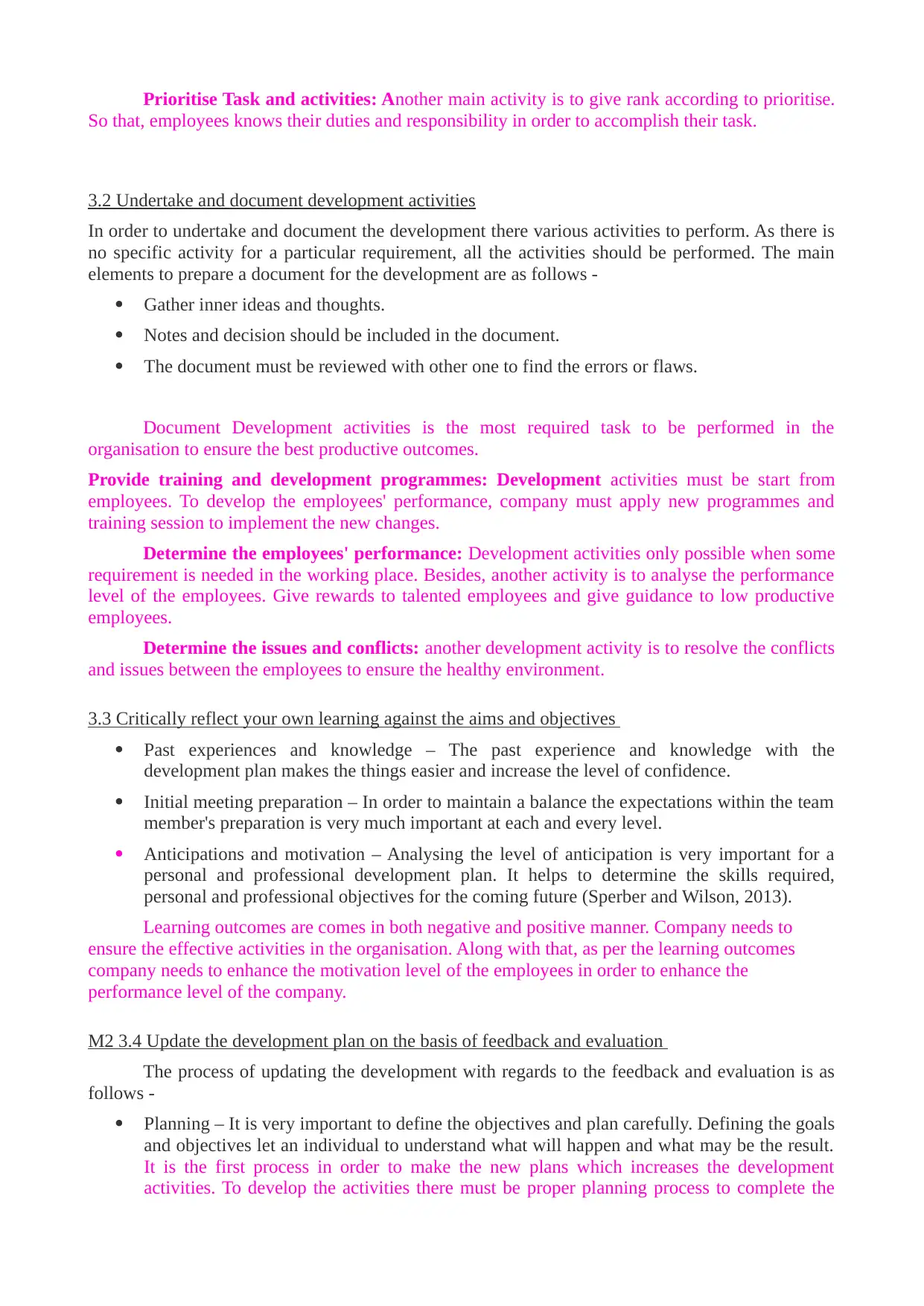
Prioritise Task and activities: Another main activity is to give rank according to prioritise.
So that, employees knows their duties and responsibility in order to accomplish their task.
3.2 Undertake and document development activities
In order to undertake and document the development there various activities to perform. As there is
no specific activity for a particular requirement, all the activities should be performed. The main
elements to prepare a document for the development are as follows -
Gather inner ideas and thoughts.
Notes and decision should be included in the document.
The document must be reviewed with other one to find the errors or flaws.
Document Development activities is the most required task to be performed in the
organisation to ensure the best productive outcomes.
Provide training and development programmes: Development activities must be start from
employees. To develop the employees' performance, company must apply new programmes and
training session to implement the new changes.
Determine the employees' performance: Development activities only possible when some
requirement is needed in the working place. Besides, another activity is to analyse the performance
level of the employees. Give rewards to talented employees and give guidance to low productive
employees.
Determine the issues and conflicts: another development activity is to resolve the conflicts
and issues between the employees to ensure the healthy environment.
3.3 Critically reflect your own learning against the aims and objectives
Past experiences and knowledge – The past experience and knowledge with the
development plan makes the things easier and increase the level of confidence.
Initial meeting preparation – In order to maintain a balance the expectations within the team
member's preparation is very much important at each and every level.
Anticipations and motivation – Analysing the level of anticipation is very important for a
personal and professional development plan. It helps to determine the skills required,
personal and professional objectives for the coming future (Sperber and Wilson, 2013).
Learning outcomes are comes in both negative and positive manner. Company needs to
ensure the effective activities in the organisation. Along with that, as per the learning outcomes
company needs to enhance the motivation level of the employees in order to enhance the
performance level of the company.
M2 3.4 Update the development plan on the basis of feedback and evaluation
The process of updating the development with regards to the feedback and evaluation is as
follows -
Planning – It is very important to define the objectives and plan carefully. Defining the goals
and objectives let an individual to understand what will happen and what may be the result.
It is the first process in order to make the new plans which increases the development
activities. To develop the activities there must be proper planning process to complete the
So that, employees knows their duties and responsibility in order to accomplish their task.
3.2 Undertake and document development activities
In order to undertake and document the development there various activities to perform. As there is
no specific activity for a particular requirement, all the activities should be performed. The main
elements to prepare a document for the development are as follows -
Gather inner ideas and thoughts.
Notes and decision should be included in the document.
The document must be reviewed with other one to find the errors or flaws.
Document Development activities is the most required task to be performed in the
organisation to ensure the best productive outcomes.
Provide training and development programmes: Development activities must be start from
employees. To develop the employees' performance, company must apply new programmes and
training session to implement the new changes.
Determine the employees' performance: Development activities only possible when some
requirement is needed in the working place. Besides, another activity is to analyse the performance
level of the employees. Give rewards to talented employees and give guidance to low productive
employees.
Determine the issues and conflicts: another development activity is to resolve the conflicts
and issues between the employees to ensure the healthy environment.
3.3 Critically reflect your own learning against the aims and objectives
Past experiences and knowledge – The past experience and knowledge with the
development plan makes the things easier and increase the level of confidence.
Initial meeting preparation – In order to maintain a balance the expectations within the team
member's preparation is very much important at each and every level.
Anticipations and motivation – Analysing the level of anticipation is very important for a
personal and professional development plan. It helps to determine the skills required,
personal and professional objectives for the coming future (Sperber and Wilson, 2013).
Learning outcomes are comes in both negative and positive manner. Company needs to
ensure the effective activities in the organisation. Along with that, as per the learning outcomes
company needs to enhance the motivation level of the employees in order to enhance the
performance level of the company.
M2 3.4 Update the development plan on the basis of feedback and evaluation
The process of updating the development with regards to the feedback and evaluation is as
follows -
Planning – It is very important to define the objectives and plan carefully. Defining the goals
and objectives let an individual to understand what will happen and what may be the result.
It is the first process in order to make the new plans which increases the development
activities. To develop the activities there must be proper planning process to complete the
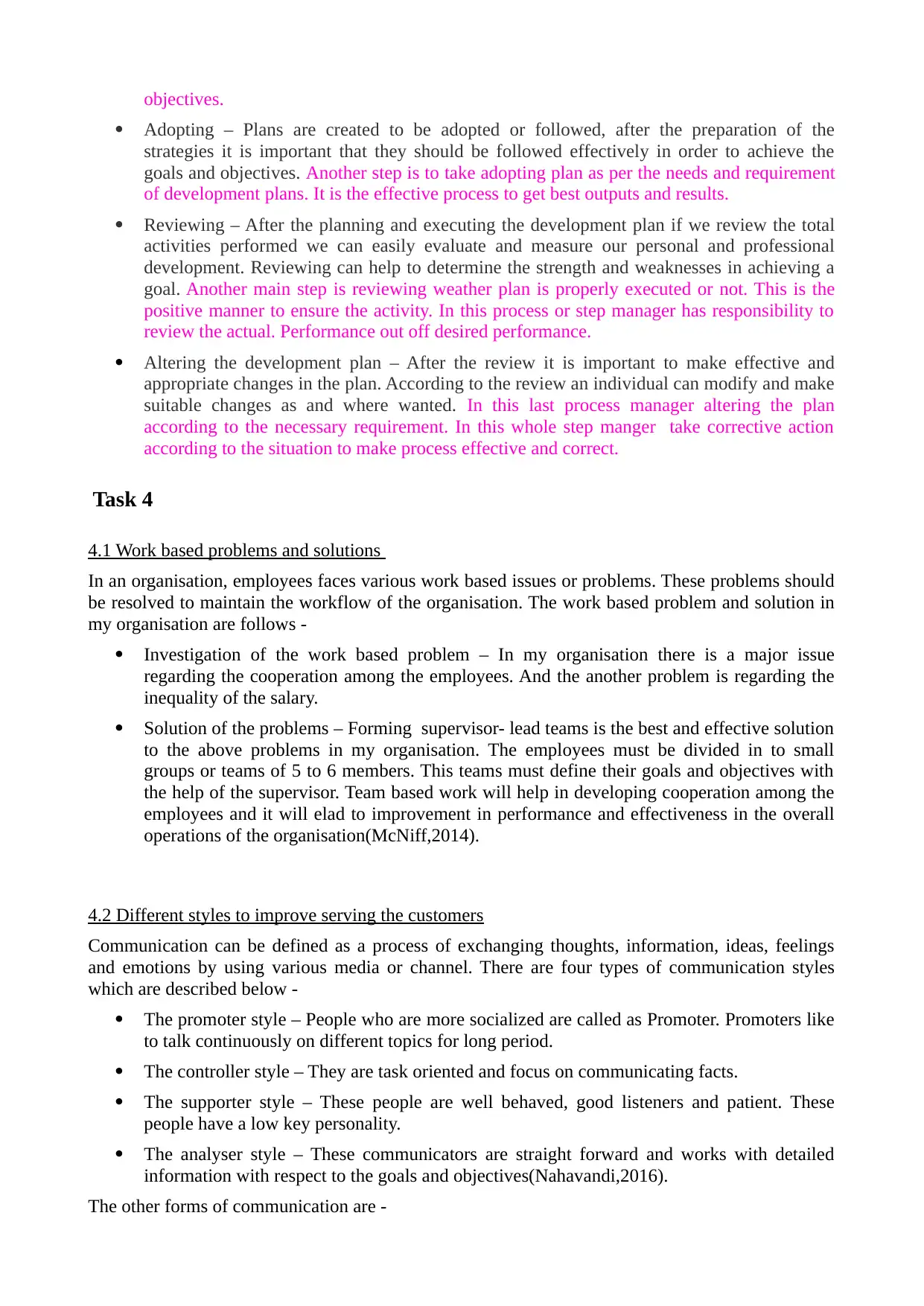
objectives.
Adopting – Plans are created to be adopted or followed, after the preparation of the
strategies it is important that they should be followed effectively in order to achieve the
goals and objectives. Another step is to take adopting plan as per the needs and requirement
of development plans. It is the effective process to get best outputs and results.
Reviewing – After the planning and executing the development plan if we review the total
activities performed we can easily evaluate and measure our personal and professional
development. Reviewing can help to determine the strength and weaknesses in achieving a
goal. Another main step is reviewing weather plan is properly executed or not. This is the
positive manner to ensure the activity. In this process or step manager has responsibility to
review the actual. Performance out off desired performance.
Altering the development plan – After the review it is important to make effective and
appropriate changes in the plan. According to the review an individual can modify and make
suitable changes as and where wanted. In this last process manager altering the plan
according to the necessary requirement. In this whole step manger take corrective action
according to the situation to make process effective and correct.
Task 4
4.1 Work based problems and solutions
In an organisation, employees faces various work based issues or problems. These problems should
be resolved to maintain the workflow of the organisation. The work based problem and solution in
my organisation are follows -
Investigation of the work based problem – In my organisation there is a major issue
regarding the cooperation among the employees. And the another problem is regarding the
inequality of the salary.
Solution of the problems – Forming supervisor- lead teams is the best and effective solution
to the above problems in my organisation. The employees must be divided in to small
groups or teams of 5 to 6 members. This teams must define their goals and objectives with
the help of the supervisor. Team based work will help in developing cooperation among the
employees and it will elad to improvement in performance and effectiveness in the overall
operations of the organisation(McNiff,2014).
4.2 Different styles to improve serving the customers
Communication can be defined as a process of exchanging thoughts, information, ideas, feelings
and emotions by using various media or channel. There are four types of communication styles
which are described below -
The promoter style – People who are more socialized are called as Promoter. Promoters like
to talk continuously on different topics for long period.
The controller style – They are task oriented and focus on communicating facts.
The supporter style – These people are well behaved, good listeners and patient. These
people have a low key personality.
The analyser style – These communicators are straight forward and works with detailed
information with respect to the goals and objectives(Nahavandi,2016).
The other forms of communication are -
Adopting – Plans are created to be adopted or followed, after the preparation of the
strategies it is important that they should be followed effectively in order to achieve the
goals and objectives. Another step is to take adopting plan as per the needs and requirement
of development plans. It is the effective process to get best outputs and results.
Reviewing – After the planning and executing the development plan if we review the total
activities performed we can easily evaluate and measure our personal and professional
development. Reviewing can help to determine the strength and weaknesses in achieving a
goal. Another main step is reviewing weather plan is properly executed or not. This is the
positive manner to ensure the activity. In this process or step manager has responsibility to
review the actual. Performance out off desired performance.
Altering the development plan – After the review it is important to make effective and
appropriate changes in the plan. According to the review an individual can modify and make
suitable changes as and where wanted. In this last process manager altering the plan
according to the necessary requirement. In this whole step manger take corrective action
according to the situation to make process effective and correct.
Task 4
4.1 Work based problems and solutions
In an organisation, employees faces various work based issues or problems. These problems should
be resolved to maintain the workflow of the organisation. The work based problem and solution in
my organisation are follows -
Investigation of the work based problem – In my organisation there is a major issue
regarding the cooperation among the employees. And the another problem is regarding the
inequality of the salary.
Solution of the problems – Forming supervisor- lead teams is the best and effective solution
to the above problems in my organisation. The employees must be divided in to small
groups or teams of 5 to 6 members. This teams must define their goals and objectives with
the help of the supervisor. Team based work will help in developing cooperation among the
employees and it will elad to improvement in performance and effectiveness in the overall
operations of the organisation(McNiff,2014).
4.2 Different styles to improve serving the customers
Communication can be defined as a process of exchanging thoughts, information, ideas, feelings
and emotions by using various media or channel. There are four types of communication styles
which are described below -
The promoter style – People who are more socialized are called as Promoter. Promoters like
to talk continuously on different topics for long period.
The controller style – They are task oriented and focus on communicating facts.
The supporter style – These people are well behaved, good listeners and patient. These
people have a low key personality.
The analyser style – These communicators are straight forward and works with detailed
information with respect to the goals and objectives(Nahavandi,2016).
The other forms of communication are -
⊘ This is a preview!⊘
Do you want full access?
Subscribe today to unlock all pages.

Trusted by 1+ million students worldwide
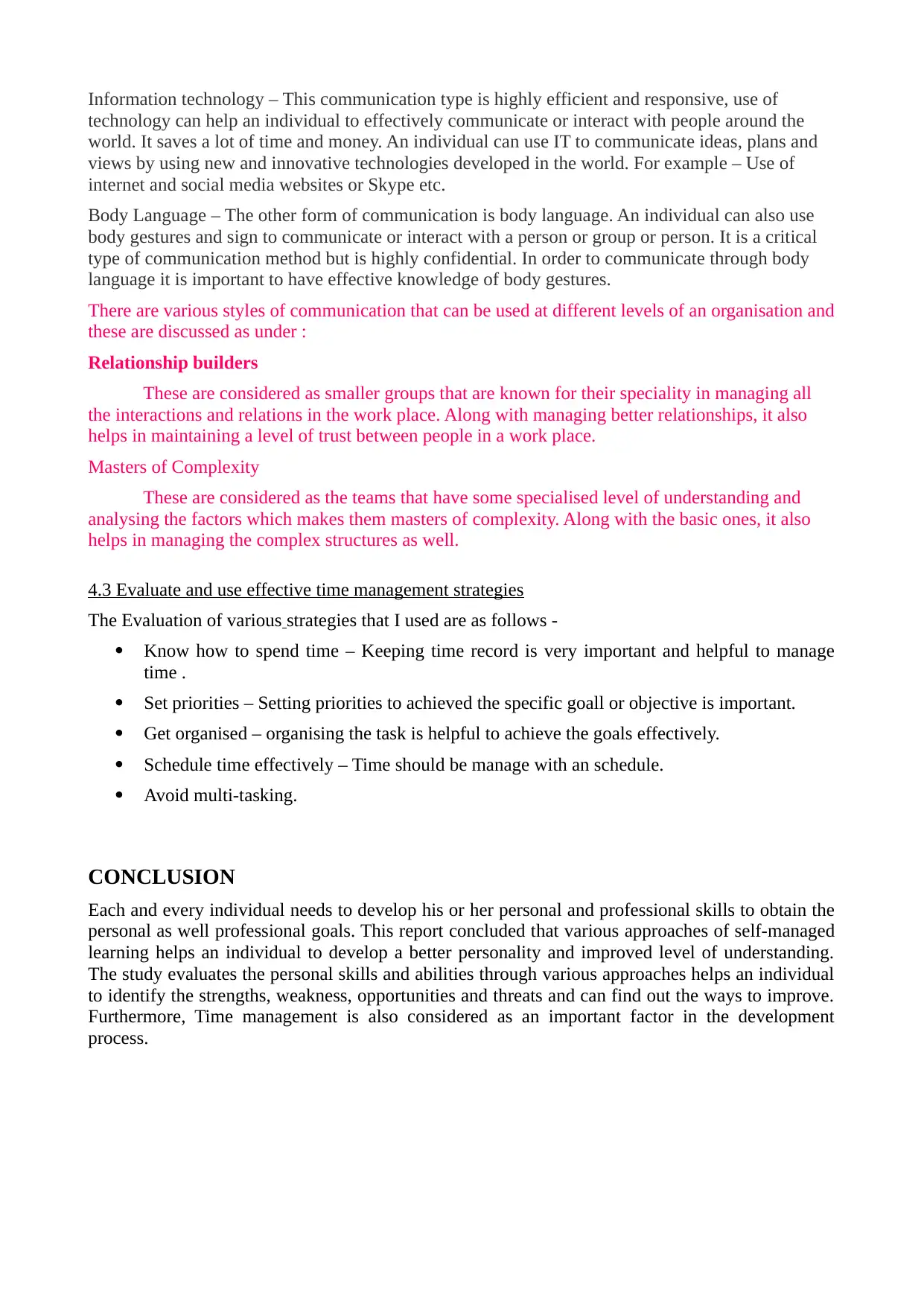
Information technology – This communication type is highly efficient and responsive, use of
technology can help an individual to effectively communicate or interact with people around the
world. It saves a lot of time and money. An individual can use IT to communicate ideas, plans and
views by using new and innovative technologies developed in the world. For example – Use of
internet and social media websites or Skype etc.
Body Language – The other form of communication is body language. An individual can also use
body gestures and sign to communicate or interact with a person or group or person. It is a critical
type of communication method but is highly confidential. In order to communicate through body
language it is important to have effective knowledge of body gestures.
There are various styles of communication that can be used at different levels of an organisation and
these are discussed as under :
Relationship builders
These are considered as smaller groups that are known for their speciality in managing all
the interactions and relations in the work place. Along with managing better relationships, it also
helps in maintaining a level of trust between people in a work place.
Masters of Complexity
These are considered as the teams that have some specialised level of understanding and
analysing the factors which makes them masters of complexity. Along with the basic ones, it also
helps in managing the complex structures as well.
4.3 Evaluate and use effective time management strategies
The Evaluation of various strategies that I used are as follows -
Know how to spend time – Keeping time record is very important and helpful to manage
time .
Set priorities – Setting priorities to achieved the specific goall or objective is important.
Get organised – organising the task is helpful to achieve the goals effectively.
Schedule time effectively – Time should be manage with an schedule.
Avoid multi-tasking.
CONCLUSION
Each and every individual needs to develop his or her personal and professional skills to obtain the
personal as well professional goals. This report concluded that various approaches of self-managed
learning helps an individual to develop a better personality and improved level of understanding.
The study evaluates the personal skills and abilities through various approaches helps an individual
to identify the strengths, weakness, opportunities and threats and can find out the ways to improve.
Furthermore, Time management is also considered as an important factor in the development
process.
technology can help an individual to effectively communicate or interact with people around the
world. It saves a lot of time and money. An individual can use IT to communicate ideas, plans and
views by using new and innovative technologies developed in the world. For example – Use of
internet and social media websites or Skype etc.
Body Language – The other form of communication is body language. An individual can also use
body gestures and sign to communicate or interact with a person or group or person. It is a critical
type of communication method but is highly confidential. In order to communicate through body
language it is important to have effective knowledge of body gestures.
There are various styles of communication that can be used at different levels of an organisation and
these are discussed as under :
Relationship builders
These are considered as smaller groups that are known for their speciality in managing all
the interactions and relations in the work place. Along with managing better relationships, it also
helps in maintaining a level of trust between people in a work place.
Masters of Complexity
These are considered as the teams that have some specialised level of understanding and
analysing the factors which makes them masters of complexity. Along with the basic ones, it also
helps in managing the complex structures as well.
4.3 Evaluate and use effective time management strategies
The Evaluation of various strategies that I used are as follows -
Know how to spend time – Keeping time record is very important and helpful to manage
time .
Set priorities – Setting priorities to achieved the specific goall or objective is important.
Get organised – organising the task is helpful to achieve the goals effectively.
Schedule time effectively – Time should be manage with an schedule.
Avoid multi-tasking.
CONCLUSION
Each and every individual needs to develop his or her personal and professional skills to obtain the
personal as well professional goals. This report concluded that various approaches of self-managed
learning helps an individual to develop a better personality and improved level of understanding.
The study evaluates the personal skills and abilities through various approaches helps an individual
to identify the strengths, weakness, opportunities and threats and can find out the ways to improve.
Furthermore, Time management is also considered as an important factor in the development
process.
Paraphrase This Document
Need a fresh take? Get an instant paraphrase of this document with our AI Paraphraser
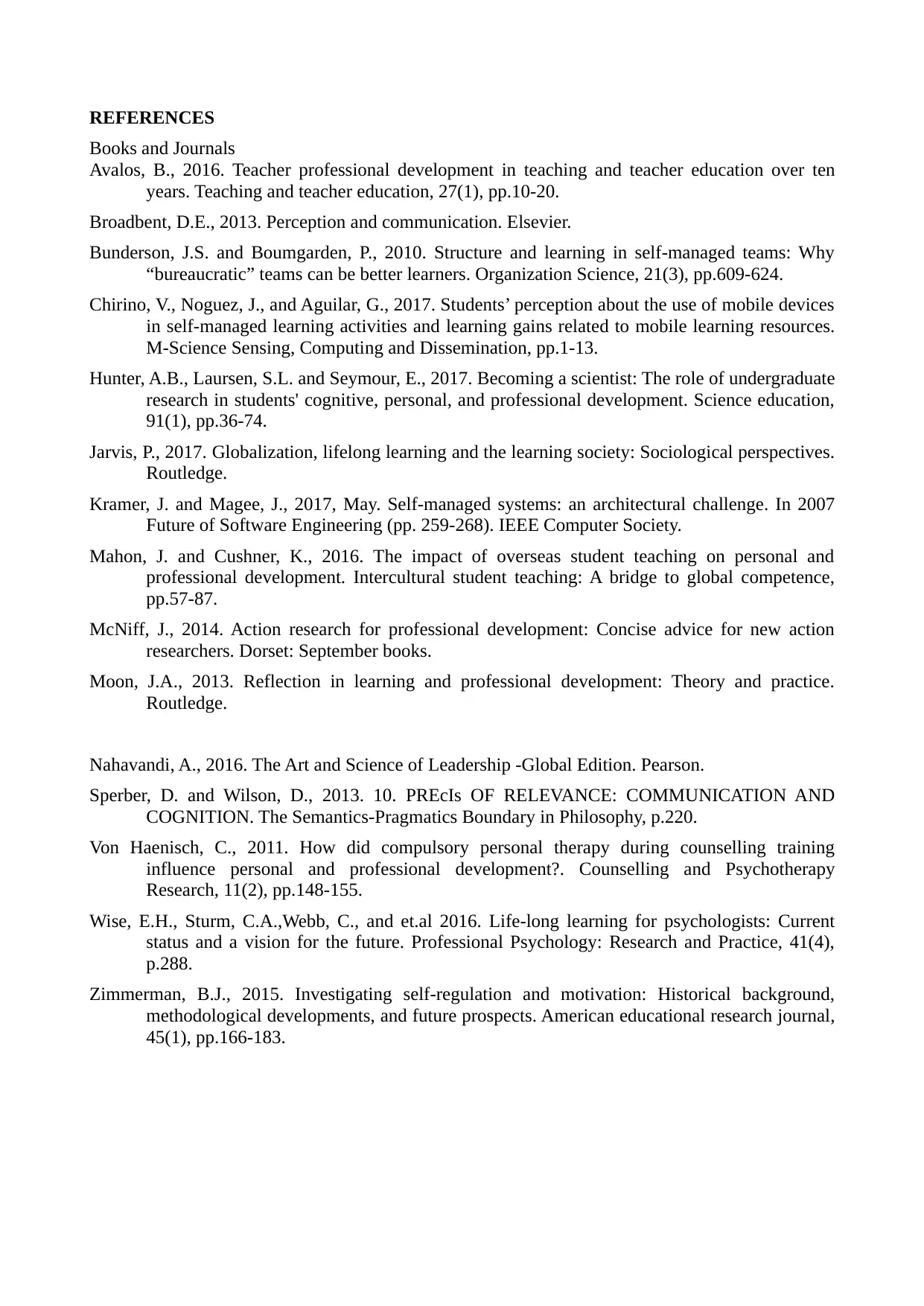
REFERENCES
Books and Journals
Avalos, B., 2016. Teacher professional development in teaching and teacher education over ten
years. Teaching and teacher education, 27(1), pp.10-20.
Broadbent, D.E., 2013. Perception and communication. Elsevier.
Bunderson, J.S. and Boumgarden, P., 2010. Structure and learning in self-managed teams: Why
“bureaucratic” teams can be better learners. Organization Science, 21(3), pp.609-624.
Chirino, V., Noguez, J., and Aguilar, G., 2017. Students’ perception about the use of mobile devices
in self-managed learning activities and learning gains related to mobile learning resources.
M-Science Sensing, Computing and Dissemination, pp.1-13.
Hunter, A.B., Laursen, S.L. and Seymour, E., 2017. Becoming a scientist: The role of undergraduate
research in students' cognitive, personal, and professional development. Science education,
91(1), pp.36-74.
Jarvis, P., 2017. Globalization, lifelong learning and the learning society: Sociological perspectives.
Routledge.
Kramer, J. and Magee, J., 2017, May. Self-managed systems: an architectural challenge. In 2007
Future of Software Engineering (pp. 259-268). IEEE Computer Society.
Mahon, J. and Cushner, K., 2016. The impact of overseas student teaching on personal and
professional development. Intercultural student teaching: A bridge to global competence,
pp.57-87.
McNiff, J., 2014. Action research for professional development: Concise advice for new action
researchers. Dorset: September books.
Moon, J.A., 2013. Reflection in learning and professional development: Theory and practice.
Routledge.
Nahavandi, A., 2016. The Art and Science of Leadership -Global Edition. Pearson.
Sperber, D. and Wilson, D., 2013. 10. PREcIs OF RELEVANCE: COMMUNICATION AND
COGNITION. The Semantics-Pragmatics Boundary in Philosophy, p.220.
Von Haenisch, C., 2011. How did compulsory personal therapy during counselling training
influence personal and professional development?. Counselling and Psychotherapy
Research, 11(2), pp.148-155.
Wise, E.H., Sturm, C.A.,Webb, C., and et.al 2016. Life-long learning for psychologists: Current
status and a vision for the future. Professional Psychology: Research and Practice, 41(4),
p.288.
Zimmerman, B.J., 2015. Investigating self-regulation and motivation: Historical background,
methodological developments, and future prospects. American educational research journal,
45(1), pp.166-183.
Books and Journals
Avalos, B., 2016. Teacher professional development in teaching and teacher education over ten
years. Teaching and teacher education, 27(1), pp.10-20.
Broadbent, D.E., 2013. Perception and communication. Elsevier.
Bunderson, J.S. and Boumgarden, P., 2010. Structure and learning in self-managed teams: Why
“bureaucratic” teams can be better learners. Organization Science, 21(3), pp.609-624.
Chirino, V., Noguez, J., and Aguilar, G., 2017. Students’ perception about the use of mobile devices
in self-managed learning activities and learning gains related to mobile learning resources.
M-Science Sensing, Computing and Dissemination, pp.1-13.
Hunter, A.B., Laursen, S.L. and Seymour, E., 2017. Becoming a scientist: The role of undergraduate
research in students' cognitive, personal, and professional development. Science education,
91(1), pp.36-74.
Jarvis, P., 2017. Globalization, lifelong learning and the learning society: Sociological perspectives.
Routledge.
Kramer, J. and Magee, J., 2017, May. Self-managed systems: an architectural challenge. In 2007
Future of Software Engineering (pp. 259-268). IEEE Computer Society.
Mahon, J. and Cushner, K., 2016. The impact of overseas student teaching on personal and
professional development. Intercultural student teaching: A bridge to global competence,
pp.57-87.
McNiff, J., 2014. Action research for professional development: Concise advice for new action
researchers. Dorset: September books.
Moon, J.A., 2013. Reflection in learning and professional development: Theory and practice.
Routledge.
Nahavandi, A., 2016. The Art and Science of Leadership -Global Edition. Pearson.
Sperber, D. and Wilson, D., 2013. 10. PREcIs OF RELEVANCE: COMMUNICATION AND
COGNITION. The Semantics-Pragmatics Boundary in Philosophy, p.220.
Von Haenisch, C., 2011. How did compulsory personal therapy during counselling training
influence personal and professional development?. Counselling and Psychotherapy
Research, 11(2), pp.148-155.
Wise, E.H., Sturm, C.A.,Webb, C., and et.al 2016. Life-long learning for psychologists: Current
status and a vision for the future. Professional Psychology: Research and Practice, 41(4),
p.288.
Zimmerman, B.J., 2015. Investigating self-regulation and motivation: Historical background,
methodological developments, and future prospects. American educational research journal,
45(1), pp.166-183.
1 out of 11
Related Documents
Your All-in-One AI-Powered Toolkit for Academic Success.
+13062052269
info@desklib.com
Available 24*7 on WhatsApp / Email
![[object Object]](/_next/static/media/star-bottom.7253800d.svg)
Unlock your academic potential
Copyright © 2020–2025 A2Z Services. All Rights Reserved. Developed and managed by ZUCOL.





